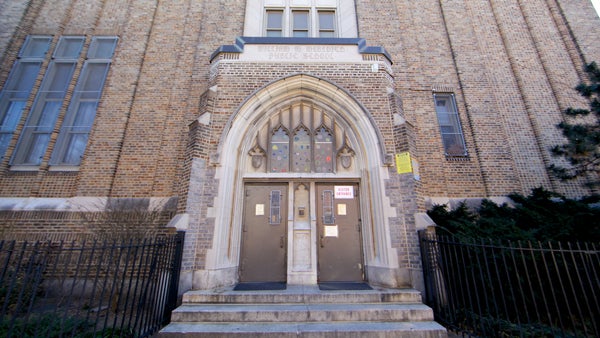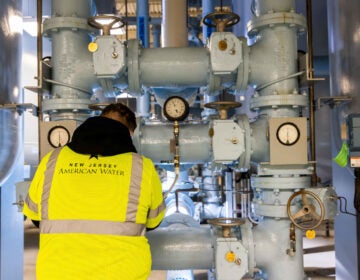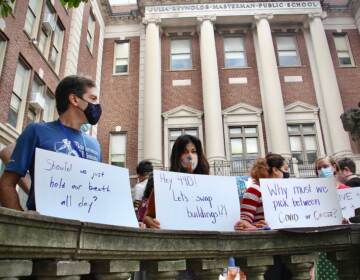Did asbestos in a Philly school cause a teacher to get cancer? It’s complicated.
A Philly teacher reportedly has cancer caused by asbestos. But should we blame the school where the person taught? It’s hard to know.

Meredith Elementary School, located on 5th and Fitzwater streets in Philadelphia. (Emma Lee/WHYY)
The Philadelphia Federation of Teachers announced Wednesday that one of its members has mesothelioma, a rare and aggressive form of cancer caused by exposure to asbestos.
PFT President Jerry Jordan says it’s the first time, as far as he knows, that a Philly educator has gotten the disease.
We know relatively little about this case of mesothelioma or what caused it.
The PFT did not release the educator’s name. Officials said the teacher worked at Nebinger School in the Bella Vista portion of Center City before moving to Meredith School in Queen Village, where the person has taught for the last 17 years.
There’s no conclusive proof that the educator’s illness was caused by working in a school with asbestos. Although Arthur Frank, an occupational health expert who works at Drexel University, told WHYY that if the educator was exposed to asbestos at a school, it would have at least contributed to the development of the disease — even if it wasn’t the original cause.
Union leaders and politicians used the announcement to redouble their calls for urgent remediation in Philly’s public schools. A coalition called “Fund Our Facilities” wants the city and state to allocate $100 million for lead and asbestos removal.
“To say enough is enough seems a little trite,” said state Rep. Brian Sims (D-Philadelphia), at a politician-packed press conference. “Enough was enough when this started.”
Jordan, the PFT president, was grim.
“The students and educators are literally risking death when they go to school,” he said. “That is a shocking, shocking thing.”
It is shocking. But it’s also hard to prove. Here’s what we know and don’t know about this case and asbestos in Philadelphia schools.
Mesothelioma is rare and deadly
Doctors diagnose about 3,000 cases of mesothelioma each year in the United States. That’s roughly one case per 100,000 people.
Between 1999 and 2017, about 50,000 people in the United States died from mesothelioma, according to the National Institute for Occupational Safety and Health. Pennsylvania had the third-highest number of deaths, behind California and Florida.
The disease is “historically” deadly, according to researchers. The vast majority of patients diagnosed with the disease die within five years.
The other thing that makes mesothelioma so notable is its link to asbestos, a mineral fiber used frequently in construction projects prior to 1980. Virtually all cases of the disease are caused by asbestos.
“It’s not a particularly common disease, but it is a particularly deadly disease and there is only one cause with regard to exposures in the United States. And that’s exposure to asbestos,” said Frank.
Asbestos use peaked in the United States in 1973, according to the National Institute for Occupational Safety and Health at 803,000 metric tons. It’s since declined to 300 metric tons.
Teachers are at greater risk for the disease
Because asbestos was so commonly found in construction materials, workers in the construction industry are at the highest risk for mesothelioma.
Other high-risk industries include shipbuilding, petroleum refining, mechanical engineering, pipefitting, and teaching.
Exposed pipes or broken tiles in old schools can release the fibers that cause mesothelioma.
One study of women diagnosed with mesothelioma found that the plurality worked in “educational services,” although the overall numbers were low. A teacher’s union in the United Kingdom claimed that more than 200 teachers have died from the disease since 2001.
The National Institute for Occupational Safety and Health found 40 occupations that put men at a higher-than-normal risk for getting mesothelioma. Only three such occupations existed for female workers: medical and health services managers, office clerks, and elementary and middle school teachers.
Among those three high-risk groups, according to NIOSH, teachers had the lowest risk.
It’s hard to trace the impact on students
Advocates with the “Fund Our Facilities” coalition say asbestos is hurting kids in Philadelphia schools.
“This stuff that’s happening to them right now may not show up until they’re married,” said Pat Eiding, president of the AFL-CIO in Philadelphia. “It may not show up for 15 or 20 years. We have to stop it now.”
That’s true. It can take decades before asbestos exposure leads to detectable cancer.
And that’s what makes it hard to understand the impact on kids, said Drexel’s Arthur Frank.
Children typically aren’t aware of potential asbestos in their environments. By the time a child grows up and develops mesothelioma, they’re probably not going to pinpoint their school environment as the culprit.
“The period between first exposure and the development of the disease generally runs in the order of 40, 45, even 50 years,” said Frank. “So somebody who may be exposed as a school child — if they get a mesothelioma when they’re 50 or 60 or 70 — is unlikely to know decades earlier they were exposed to asbestos in schools.”
And it’s hard to trace the cause of an individual case
The long latency period of mesothelioma makes it hard to know what school building, if any, caused the disease to appear in the unidentified Philadelphia teacher.
It’s possible the educator’s case stems from exposure as a child or young adult. It’s possible that the culprit was Nebinger School in Bella Vista. Or it could be that the teacher’s 17-year tenure at Meredith School in Queen Village is to blame.
Or, to make things more muddled, it could be a combination of all three.
Asbestos exposure causes cells to become cancerous, said Arthur Frank. But asbestos can also speed the development of cancer in someone who already has cancerous cells.
“So if somebody developed a cancer cell working at one school [and then] went to another school where asbestos was still present, literally the second school would not have caused the cancer cell to be developed, but would have contributed to the rapidity of the growth of that cancer,” said Frank.
Asbestos is present in both schools where the teacher reportedly worked
This much we know: There is asbestos at Nebinger and Meredith Schools.
That’s hardly unique in Philadelphia, where the vast majority of schools were built before 1980.
The Philadelphia Federation of Teachers estimates that about 175 buildings contain asbestos. The school district could not confirm that estimate or provide an exact tally.
Asbestos does not necessarily need to be removed, according to the Environmental Protection Agency.
“As long as its intact, it’s not presenting a health hazard,” said Brian Joseph, the School District of Philadelphia’s environmental director.
But if asbestos is “severely damaged or will be disturbed by a building demolition or renovation project,” schools need to take action, the EPA says.
The district says it checks each of its schools every six months to look for exposed asbestos that could cause harm. It says it has “addressed” 1,600 asbestos remediation projects over the last three years, according to Chief Operating Officer Danielle Floyd.
Among those 1,600 asbestos-remediation projects, three took place at Meredith School, according to Joseph.
School officials admit there are backlogged projects they haven’t been able to do because of budget constraints. The district will spend about $20 million on asbestos-related projects this year.
Officials say those uncompleted projects aren’t causing imminent harm to teachers or students, and that the district prioritizes cases where asbestos exposure is most severe.
“We stand behind that our buildings are safe,” said Floyd.
A recent investigation by The Philadelphia Inquirer, however, suggested that some schools have higher-than-reported levels of asbestos and indicated that some remediation projects aren’t complete with fidelity.
After that reporting, Nebinger was among the schools that underwent asbestos remediation.
WHYY is your source for fact-based, in-depth journalism and information. As a nonprofit organization, we rely on financial support from readers like you. Please give today.





